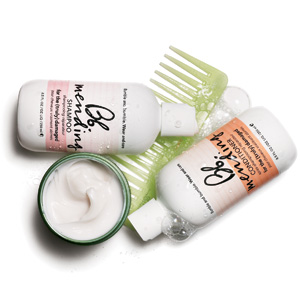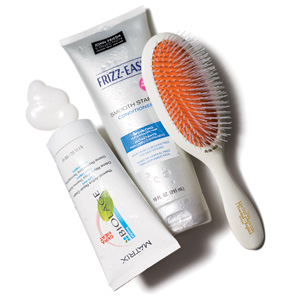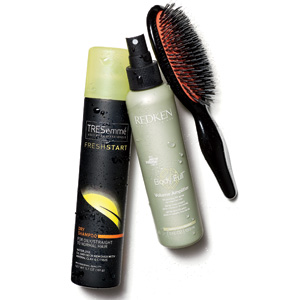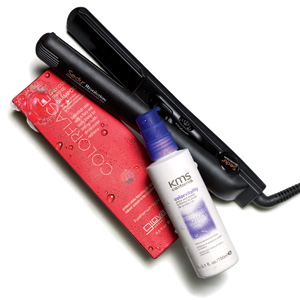
When our hair is healthy, we feel more confident and revel in its swing and shine. Still, some days (weeks? months?), our hair just refuses to cooperate, despite the attention we give it…which, ironically, is often the problem. Straightening and curling, coloring and highlighting, spritzing and scrunching—primping does a lot of damage over time.
The first step for reversing tress distress is “assessing what kind of shape the hair is in so you can treat it properly,” says styling guru Ted Gibson, owner of the Ted Gibson Salon in New York City. Find the symptoms that describe the state of your hair’s health, then remedy the situation with the right Rx for hair repair.
Split Ends & Breakage
Symptoms:
• Ends have seen more splits than a couples therapist.
• Hairs are fragile and break off during standard brushing.
• Pieces are prone to tangles and snarls.
The cause: Wear and tear is the culprit. “Chemical processing, heat styling, and long hair equals more fraying,” says David Kingsley, Ph.D., a trichologist (hair and scalp specialist) in New York. Extremely fragile hair can develop small nodes (they look like a snapped twig) where the hair has shattered.
The cure: Choose demipermanent hair color over ammonia-or peroxide-laden permanent color; it’s gentler and won’t strip your strands. Avoid highlighting, and don’t overwash (every other day is enough) because strands can snap when wet. Opt for shampoos and conditioners that are for damaged or broken strands. They contain more hydrating and strengthening ingredients.
Dry hair needs humectants to boost its elasticity. If it’s brittle with breakage, look for styling aids that contain keratin, wheat, or soy protein; they bond to hair proteins to reinforce delicate strands. Try a weekly deep-conditioning treatment that contains natural oils, says Ni’Kita Wilson, a cosmetics chemist in New Jersey. The oils will support sebum to coat each strand.
Style Fixes:
Get a trim every four to six weeks. Ask your stylist to snip off an eighth of an inch to remove dead ends but keep your length. “Short frazzled hair can look like a wig,” explains Jet Rhys, owner of Jet Rhys Salons in San Diego.
Go longer between coloring. “If you still want to color your hair despite its damage, address only the new growth,” says celebrity colorist Jason Backe. Between color treatments, use a color-depositing pen to cover your roots.
Start a strength-building regimen. Gibson recommends stocking up on styling products that are packed with proteins that reinforce strands by “spackling” weak spots. Softer styles like loose waves will disguise fried ends.
 Dry & Frizzy
Dry & Frizzy
Symptoms:
• Strands expand into an unruly puffball at the first hint of humidity.
• You suffer from UFS (uncontrollable flyaway syndrome).
• Hair feels coarse or roughed up.
The cause:
Genes are to blame, but overenthusiastic heat styling exacerbates the problem. “Women with this hair type generally have an average of 80,000 hairs on the scalp [compared with the 100,000 average], so fewer oil glands are covering a larger surface area,” Kingsley says. No wonder your hair is so thirsty! You likely have natural waves or curls, so your cuticles tend to lift up, making strands porous. Attempting to tame frizz with a blow-dryer, flat iron, or chemical process disrupts the cuticles, worsening the effect.
The cure: Dehydrated hair needs lots of moisture, so try shampooing just two or three times a week. Use cleansers and conditioners with dimethicone, shea butter, or nut oil. Says Wilson: “In the shower, these ingredients trap water inside the hair shaft, boosting moisture, before sealing the cuticle.”
Use lighter hydrating creams that will keep out external moisture. These products include organic oils that do a great job of coating the cuticle and infusing shine. But beware: They aren’t heatprotective like silicone. “Like cooking oil, these oils will fry your hair instead,” says Wilson, so don’t use them as a pretreatment.
Style Fixes:
Go long, with soft layers starting at the chin. Length helps the hair lie flatter, while layers bring in fullness without contributing to the pouf factor. “If your layers are too short, your hair will look choppy, which highlights frizz,” Rhys says.
Turn to the dark side. Lighteners and highlights make dryness worse. “Stick to demi-permanent dyes, which give hair luster,” Backe says. They contain no damaging ammonia and very little peroxide, and last around 25 shampoos. Just stay within two shades of your natural color.
Manage the heat. Run a heat-protective smoothing cream through nearly dry strands, then blow-dry. And avoid flat ironing immediately after drying. “Let your hair cool for five minutes before exposing it to more heat,” Rhys advises.
 Limp & Oily
Limp & Oily
Symptoms:
• Baby-fine strands exhibit loss of volume.
• Over the course of the day, your ‘do becomes as greasy as a side of fries.
• Hair is droopy, dull, and won’t hold a style.
The cause:
Blame your parents: Genes control the size and shape of your follicles. Fine hairs have a flimsier internal structure than coarser ones do. And though you have as much as a third more hair on your head than women with thicker locks, sadly this makes for less volume, not more. “Each hair follicle has at least one oil gland attached to it,” Kingsley explains. “Less surface area means oil covers more of it, making it limp.”
The cure:
Wash your hair daily to rinse away the greasy stuff, called sebum. Wilson recommends using an oily-hair shampoo that is “free of heavy oils and silicones like dimethicone. These ingredients are for dry or damaged hair and leave behind a residual film to seal cuticles. That buildup deprives your hair of body.” Try a clarifying shampoo once a week to eliminate lingering product. Also, use conditioner sparingly, from the middle of your strands to the ends, says celebrity hairstylist Sally Hershberger, who also cautions against steamy showers: “Hot water aggravates the scalp and causes sebaceous glands to produce more oil.”
Stock your vanity with two types of stylers: volumizing sprays and lotions that plump up strands. These lightweight products coat the individual hairs, making them look thicker. Also, use a dry shampoo to soak up oil and impart texture.
Style Fixes:
Try a “lob” (a long bob) with soft layers around the face.Boosting volume is key, so Gibson advises against superlong hair that will lie flat against your scalp. Consider cutting it to chin length or right above the shoulders. Ask your stylist to leave the back all one length and to add side-swept bangs or soft face-framing layers for more motion.
Reach for hair color. All permanent hair-color products open the cuticles and expand the strands, making them weightier, but bleach lifts them even more, providing texture and bounce. “Bleached highlights bring in visual dimension and contrast, which gives the illusion of more hair,” says Backe, who adds medium-width highlights at the crown for fullness.
Apply products properly. To create volume at the roots, “blast a generous amount of thickening spray close to the scalp, and massage it in with your fingers,” Rhys says. “But no brushing at the roots. It will flatten your style.” If your strands lose steam by midday, revive their texture with dry shampoo: Sprinkle it onto your scalp, flip your hair over, and work it in.
 Dull & Faded
Dull & Faded
Symptoms:
• Locks that were once radiant now refuse to shine.
• Blondes look ashy; brunettes look dingy or gray; redheads become brassy or orange.
• Hair color looks lighter instead of rich and vibrant.
The cause:
When the outer cuticle is roughed up by chemical processes or hot-tool overkill, parts of the cortex are exposed and damaged, and the hair becomes more porous. As a result, strands no longer accept dye as readily and the color pigments seep out in the shower. Also, styling-product buildup can give hair a lackluster appearance.
The cure:
Reduce the fading with shampoos and conditioners that help preserve color. “These work by depositing more pigment onto the surface of your strands,” Wilson says. “But they don’t last the way permanent dyes do, so the results rinse away if you don’t use them regularly.” Also try styling products that contain broad-spectrum UV filters; they create a barrier against pigmentdegrading rays.
To bolster your hair’s shine, style your ‘do with cuticle-smoothing products that contain natural oils or silicone. “That’s how you’re going to get that major glossy sheen,” Rhys says.
Style Fixes:
Layer up. Swingy sections that fall together boost body while allowing light to reflect evenly for allover luster.
Let it shine. “A glossing treatment will give you about a month of supershiny hair,” Backe says. These ammonia-free formulas, like Clairol Natural Instincts Shine Happy, are far less damaging than permanent color. Try one that is crystal-clear or go for a gloss that has a sheer wash of color-refreshing pigment.
Stick to soft, touchable styles. Teasing and volumizing really highlight dullness, so don’t go for too much fullness, Rhys suggests. “Keep your hair nice and sleek so the light bounces off it.” Use a silicone spray for polish.

